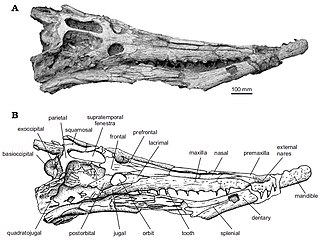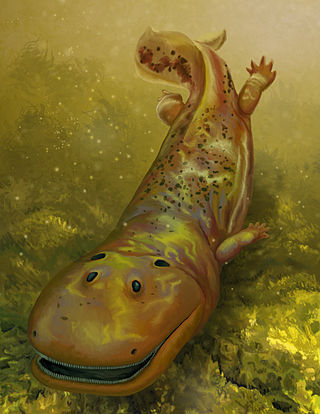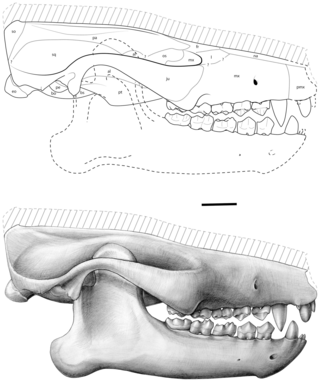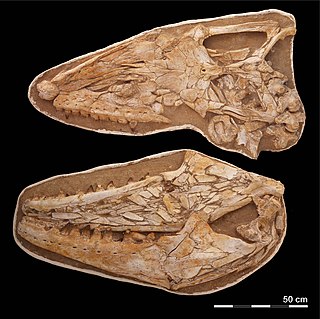
The nasal bones are two small oblong bones, varying in size and form in different individuals; they are placed side by side at the middle and upper part of the face and by their junction, form the bridge of the upper one third of the nose.

Archelon is an extinct marine turtle from the Late Cretaceous, and is the largest turtle ever to have been documented, with the biggest specimen measuring 4.6 m (15 ft) from head to tail and 2.2–3.2 t in body mass. It is known only from the Pierre Shale and has one species, A. ischyros. In the past, the genus also contained A. marshii and A. copei, though these have been reassigned to Protostega and Kansastega, respectively. The genus was named in 1895 by American paleontologist George Reber Wieland based on a skeleton from South Dakota, who placed it into the extinct family Protostegidae. The leatherback sea turtle was once thought to be its closest living relative, but now, Protostegidae is thought to be a completely separate lineage from any living sea turtle.

A flipper is a broad, flattened limb adapted for aquatic locomotion. It refers to the fully webbed, swimming appendages of aquatic vertebrates that are not fish.

Gastonia is a genus of herbivorous ankylosaurian dinosaur from the Early Cretaceous of North America, around 139 to 134.6 million years ago. It is often considered a nodosaurid closely related to Polacanthus. Gastonia has a sacral shield and large shoulder spikes.

Dyrosauridae is a family of extinct neosuchian crocodyliforms that lived from the Campanian to the Eocene. Dyrosaurid fossils are globally distributed, having been found in Africa, Asia, Europe, North America and South America. Over a dozen species are currently known, varying greatly in overall size and cranial shape. A majority were aquatic, some terrestrial and others fully marine, with species inhabiting both freshwater and marine environments. Ocean-dwelling dyrosaurids were among the few marine reptiles to survive the Cretaceous–Paleogene extinction event.

Protostegidae is a family of extinct marine turtles that lived during the Cretaceous period. The family includes some of the largest sea turtles that ever existed. The largest, Archelon, had a head one metre (39 in) long. Like most sea turtles, they had flattened bodies and flippers for front appendages; protostegids had minimal shells like leatherback turtles of modern times.

Bouliachelys is an extinct genus of sea turtle from Cretaceous Australia. It was originally described as a member of Protostegidae. In 2013 study it was considered to be a member of Dermochelyoidae, although later studies consider it as a protostegid again.

Spathicephalus is an extinct genus of stem tetrapods that lived during the middle of the Carboniferous Period. The genus includes two species: the type species S. mirus from Scotland, which is known from two mostly complete skulls and other cranial material, and the species S. pereger from Nova Scotia, which is known from a single fragment of the skull table. Based on the S. mirus material, the appearance of Spathicephalus is unlike that of any other early tetrapod, with a flattened, square-shaped skull and jaws lined with hundreds of very small chisel-like teeth. However, Spathicephalus shares several anatomical features with a family of stem tetrapods called Baphetidae, leading most paleontologists who have studied the genus to place it within a larger group called Baphetoidea, often as part of its own monotypic family Spathicephalidae. Spathicephalus is thought to have fed on aquatic invertebrates through a combination of suction feeding and filter feeding.

The skull roof or the roofing bones of the skull are a set of bones covering the brain, eyes and nostrils in bony fishes and all land-living vertebrates. The bones are derived from dermal bone and are part of the dermatocranium.

Acamptonectes is a genus of ophthalmosaurid ichthyosaurs, a type of dolphin-like marine reptiles, that lived during the Early Cretaceous around 130 million years ago. The first specimen, a partial adult skeleton, was discovered in Speeton, England, in 1958, but was not formally described until 2012 by Valentin Fischer and colleagues. They also recognised a partial subadult skeleton belonging to the genus from Cremlingen, Germany, and specimens from other localities in England. The genus contains the single species Acamptonectes densus; the generic name means "rigid swimmer" and the specific name means "compact" or "tightly packed".

Caupedactylus is an extinct genus of tapejarid azhdarchoid pterosaur known from the Early Cretaceous period of what is now the Romualdo Formation of the Araripe Basin in northeastern Brazil. The type and only species of Caupedactylus is Caupedactylus ybaka.

Entelognathus primordialis is an early placoderm from the late Silurian of Qujing, Yunnan, 419 million years ago.

Ocepeia is an extinct genus of afrotherian mammal that lived in present-day Morocco during the middle Paleocene epoch, approximately 60 million years ago. First named and described in 2001, the type species is O. daouiensis from the Selandian stage of Morocco's Ouled Abdoun Basin. A second, larger species, O. grandis, is known from the Thanetian, a slightly younger stage in the same area. In life, the two species are estimated to have weighed about 3.5 kg (7.7 lb) and 10 kg (22 lb), respectively, and are believed to have been specialized leaf-eaters. The fossil skulls of Ocepeia are the oldest known afrotherian skulls, and the best-known of any Paleocene mammal in Africa.

The Oulad Abdoun Basin is a phosphate sedimentary basin located in Morocco, near the city of Khouribga. It is the largest in Morocco, comprising 44% of Morocco's phosphate reserves, and at least 26.8 billion tons of phosphate. It is also known as an important site for vertebrate fossils, with deposits ranging from the Late Cretaceous (Cenomanian-Turonian) to the Eocene epoch (Ypresian), a period of about 25 million years.

Rhinochelys is an extinct genus of sea turtles belonging to the family Protostegidae.

Alienochelys is an extinct genus of sea turtle known from Maastrichian-aged Cretaceous phosphates in Morocco. With a skull measuring 41.5 centimetres (1.36 ft) long, it would have been a very large turtle. It was first described as a member of the family Dermochelyidae, meaning that it is a relative of the modern leatherback turtle, though a 2018 study identifies it as a sister taxon of Ocepechelon belonging to the family Protostegidae, indicating that it may have been closer to the extinct Archelon. Unlike other sea turtles, Alienochelys' the jaws being adapted for a powerful crushing pattern well adapted for a durophagous lifestyle, as well as its unusual cranial characteristics.

Apatorhamphus is an extinct genus of azhdarchoid pterosaur from the Kem Kem Group of Morocco. It might have been part of the Chaoyangopteridae. It is only known from a few snout fragments and it likely had a wingspan of between 3–7 metres (9.8–23.0 ft)
Zolhafah is an extinct genus of bothremydid pleurodiran turtle that was discovered in the Western Desert of Egypt. The genus consists solely of type species Z. bella.

Thalassotitan is an extinct genus of large mosasaurs that lived during the late Maastrichtian of the Cretaceous period in what is now Morocco, around 66 million years ago. The only known species is T. atrox, described in 2022 from fossils discovered in the Ouled Abdoun Basin, where many other mosasaurs have been found. It was assigned to the tribe Prognathodontini alongside other mosasaurs like Prognathodon and Gnathomortis. The prognathodontines are separated from other mosasaurs based on their massive jaws and robust teeth.
This list of fossil reptiles described in 2014 is a list of new taxa of fossil reptiles that were described during the year 2014, as well as other significant discoveries and events related to reptile paleontology that occurred in 2014.



















